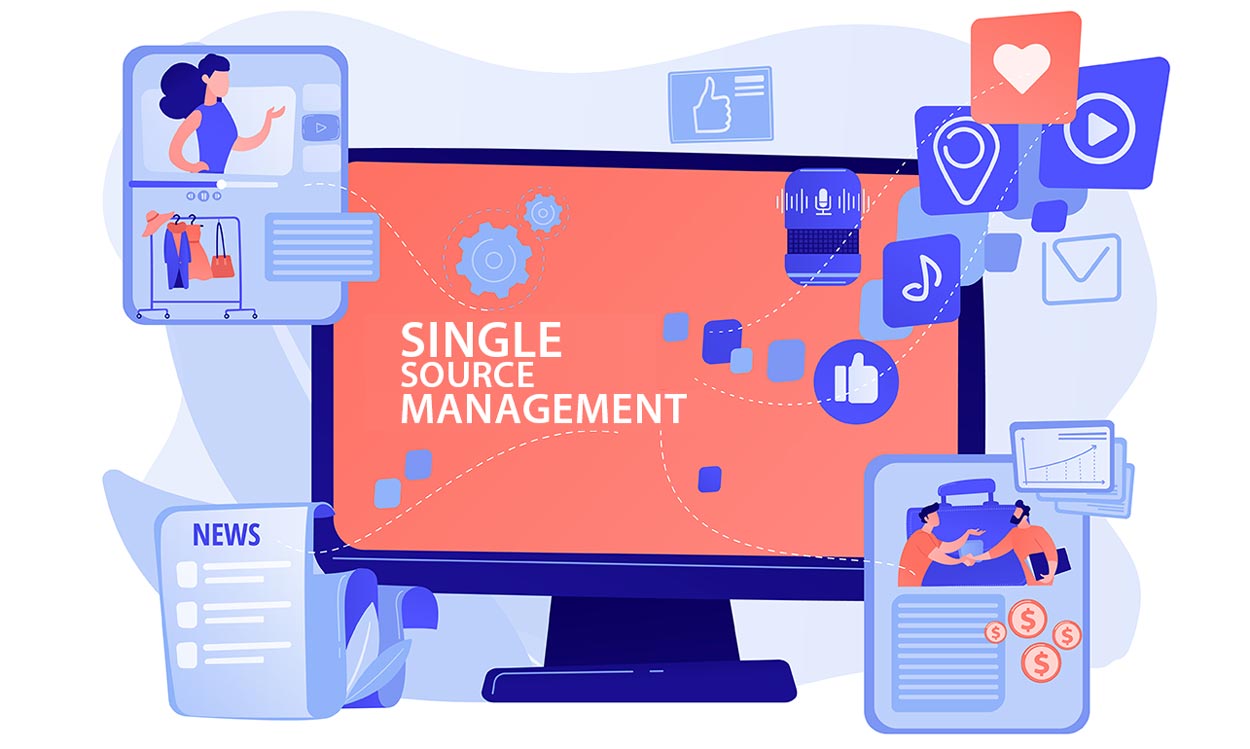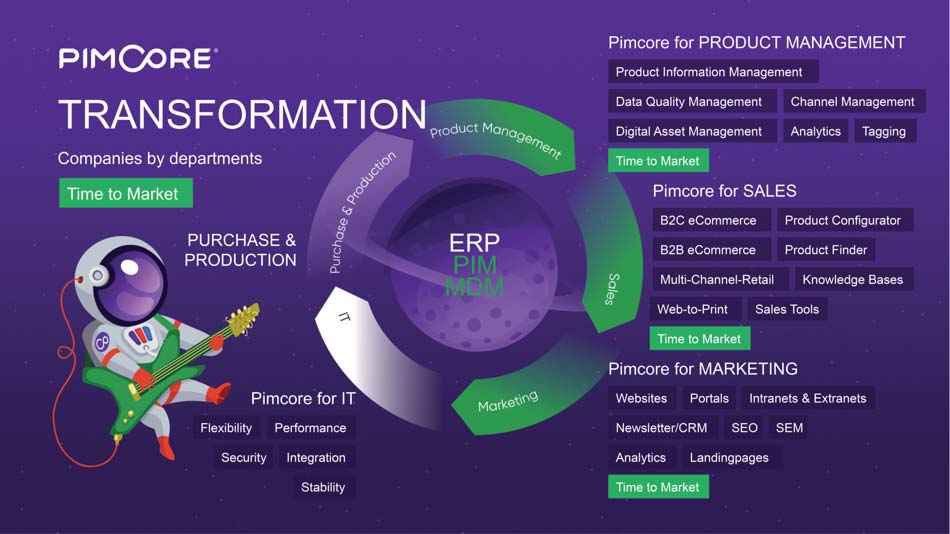What is a single source of management?
A single source of management approach is a strategic way to use the information and knowledge that is contained in your systems and around your organisation.
When this approach is employed around your business, information is accurate, up to date and can be used in multiple ways by the people who need it.

Image by vectorjuice on Freepik
Data spread around networks
It is estimated that the average enterprise business, with a staff team of 51-100 people has 79 different apps and systems in use! That’s almost one system per person. Can you imagine the time spent creating, updating, sharing and conducting training in all of these apps?
When data is spread through different systems, the time spent handling it can blow out. It makes it difficult for people to get information across teams and departments. Often what happens is that people stick to what they know, and lose out on the opportunities that a cohesive data set can provide.
Even in organisations where there is a central file storage system, very often, these systems have data that is lacking integrity. Staff come and go, users create their own rules, and with no process for version control, it’s impossible to know which version a resource you should be using.
Procedures might have been ignored, and keywords have gone out the window. If you’re using something like Google Drive or Dropbox, files need to be downloaded locally every time they are required, and it’s impossible to see changes that are underway. Dealing with disparate data systems cost you time and money.
If your data is scattered across multiple systems and platforms and you want to sort out your data problems once and for all, you don’t need to start from the beginning again. Instead of recreating all of your precious organisational knowledge and information, invest in a system that combines, collaborates and creates a cohesive set of data.
Research has found that:
- Only a third of all enterprise leaders and CEOs are entirely confident in the accuracy of the information they use to run their business
- Almost half of all companies don’t operate from single-source systems, and most of them have their essential operational data residing in spreadsheets only
- The amount of companies who admit to regularly encountering data errors in their spreadsheets and documents is also almost 50%
- Resolving data management issues can require external support and cost thousands of dollars every year, not to mention costs to efficiency
- Businesses that do not have a consistent data approach recognise that poor data handling is detrimental to their business, but most don’t know how to resolve their information issues
- About 70% of executives recongise they need to be smarter with their data from within the organisation to gain business benefits
What single source of management means for your business
When you adopt a since source of management across your business, dealing with data will get easier. The amount of time wasted searching for files and duplicating effort in document creation will be reduced. Those data silos that kept important information from getting out to where it needed to go will dissolve.
You will also be able to set up consistent, across-the-board data rules and information governance so that each person has access to complete the content tasks that they need to be able to do. Content will be consistent. No incorrect details, times, products or prices on your website. No old files hanging around.
Just a robust system for tidy, relevant and user-centric data that can be accessed by the people who need it, when they need it.
Version control will become a breeze. You’ll have a centralised set of data that you can interrogate to be able to view previous versions, comments and changes on any file. You’ll have a central interface, with easy-to-access and operate dashboards. You’ll have a much clearer picture of what information you have, how it’s performing and where the gaps are.
How to benefit from single source of management
You’ll notice the benefits of single source pretty quickly. These benefits include:
- Accurate and accessible data, information and knowledge
- Reduction in the amount of time that staff spend on dealing with outdated data
- Increased productivity and efficiency
- The ability to roll out changes and updates across multiple sites, systems and platforms
- An improved internal communication system, which builds internal relationships and allows staff to collaborate in real-time
- Improved brand profile with website that are streamlined, accurate and give great customer experienced
Defining single source of management
Single source of management is related to how a business uses its information, data and knowledge. It involves applying systems, software, and processes so that information is held centrally in a way that everyone is familiar with.
A single source of management approach means that you create a trusted location for information, where this information has authority over other systems or activities. The most up-to-date and accurate information is published and distributed to wherever it needs to go in the organisation. Everyone can access the new information instantly.
Single source of management approaches can include any decisions, processes, and operations and function across all sections of the organisation; from marketing, information technology, management, projects, sales, and products.

How to manage data to a single source
There are master data systems that can sit over the top of others, collecting the data that is required. It can pull content from your existing systems and transform it into the format used by the master system. Your original data is kept, and you’re not at risk of data loss. Using Cloud technologies, you improve access to dated information, reducing delays in searching through older systems.
Using single source of management to promote collaboration
Creating opportunities for teams to collaborate is what allows innovation to occur. To solve complex customer problems and fully understand your customers’ perspectives, you’ll need people to be working together in a creative and forward-thinking way. To do this when you have teams dealing in different systems is very hard. They get bogged down with their own processes, tasks, and data requirements that they haven’t got time to check in on what other departments are doing.
A single source system will reduce the amount of time spend managing email, looking for internal information or trying to work out who has access to certain information sets.
Options for using legacy data systems
If the task of integrating your disparate legacy systems seems overwhelming, don’t despair. In many cases, it is simply not profitable for companies to start again with their data, and most will be left with data in legacy systems for many years to come. To achieve a successful single source of management approach, you don’t have to dismantle all of the work that has already been done. There are systems options to support you moving forward.

How to prepare data to present from multiple sources
Before you implement a single source, you will need to assess each existing system and understand its security functions and access settings. It is worth running data integrity reports and duplication reports and consolidating any data sets possible. If data is moving around in preparation for the roll out, keeping it secure at both the point of origin and in transit is important, as is ensuring pre-production data doesn’t accidentally end up publicly viewable.
What types of data can benefit from a single source of truth
The types of data held by an organisation will always vary. But when we are talking about a single source of management in relation to data, it could refer to any information that is collected or created through the operation of the business. It can be qualitative or qualitative; it could be structured or unstructured. For your business, this might mean information related to:
- Employees
- Finances
- Customers
- Digital marketing
- Transactions
- Emails
- Product information
- Procedures
- Branding resources
- Photography and videos
Using Pimcore as a single source of truth
Pimcore is an excellent choice for any commercial or enterprise business that wants a system to support a single source of truth approach. Pimcore centralises data from any number of separate channels and systems and enables you to manage all of your information requirements. From managing people to projects, products to processes, Pimcore will improve your productivity, reduce costs and maximise efficiencies around your organisation.
From saving tonnes of time spent searching for files, to reducing data silos and encouraging collaboration, a single source of truth is a model worth considering. Most businesses with over 100 employees are considered to have very basic or beginner data maturity levels. Using Pimcore to establish a single source of truth will help you progress your organisation’s position in terms of data maturity.
Pimcore as your master data management platform
Get up to speed and get your data where it needs to be with a master data system. Systems like Pimcore can enable you to:
- Handle with confidence even the most complex data your business is generating
- Enrich and consolidate information across multiple domains
- Control millions of records with thousands of individual attributes
- Set up an unlimited number of channels and users
- Store information on site or in the cloud